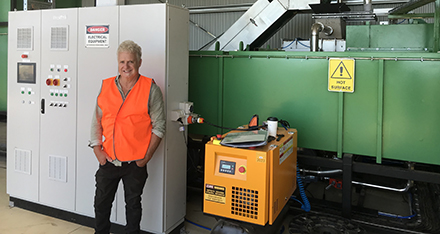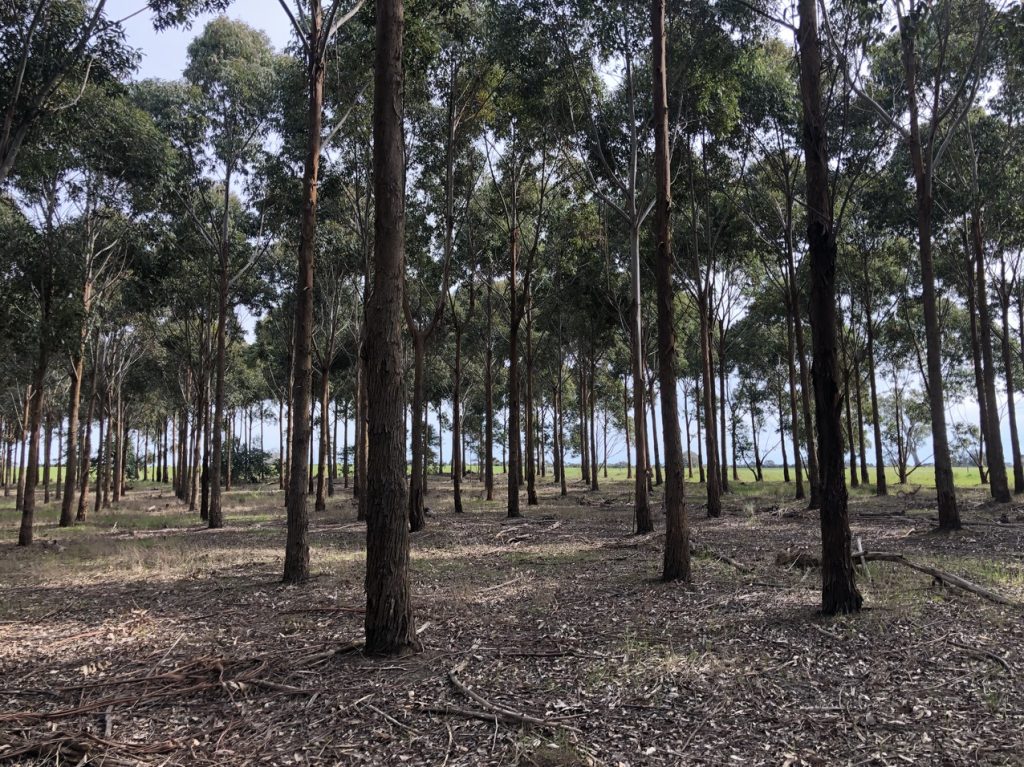


Hardwood Plantations
Our vision is to become totally self sufficient by managing our own durable, native plantations. In 2004 we established a 30 year plan to plant up to 2000 hectares of durable Australian hardwoods for future generations. To date we have planted over 1 million trees
Why Plantation Timber?
Using plantation timber offers a range of benefits both environmentally, and economically whilst also having a positive income on the building and construction industry. Key advantages include:-

Environmental benefits:
- Biodiversity Preservation: By planting native hardwood species, you contribute to maintaining and restoring the natural ecosystem. These plantations can provide habitats for native wildlife, including birds, insects, and small mammals, thus supporting biodiversity conservation.
- Carbon Sequestration: Hardwood trees have the ability to sequester carbon dioxide from the atmosphere through photosynthesis. As they grow, they store carbon in their biomass and in the soil, helping mitigate climate change by reducing the concentration of greenhouse gases.
- Soil Conservation: Native hardwood trees often have deep root systems that help prevent soil erosion. They stabilize the soil, reducing the risk of landslides and maintaining soil fertility.
- Water Quality and Quantity: Planting native hardwoods can improve water quality by filtering pollutants and reducing runoff into waterways. Their roots also help to absorb excess water during heavy rainfall, reducing the risk of flooding.
- Fire Resistance: Some native hardwood species are adapted to fire-prone environments. Planting these species in strategic locations can help create fire-resistant landscapes and reduce the risk of catastrophic wildfires by acting as firebreaks or by slowing the spread of flames.
- Reduced Chemical Inputs: Native hardwood trees are often well-adapted to local climatic and soil conditions, requiring fewer pesticides, herbicides, and fertilizers compared to exotic species.
- Habitat Connectivity: Establishing native hardwood plantations can contribute to creating corridors that connect fragmented habitats, allowing for the movement of wildlife.
Economical benefits:
- Timber Production: One of the primary economic benefits of native hardwood plantations is the production of high-quality timber. Timber harvested from these plantations can be used in a wide range of applications, including construction, furniture making, flooring, and decking.
- Job Creation: Establishing and managing native hardwood plantations create employment opportunities across various sectors, including forestry, silviculture, harvesting, processing, and transportation. These jobs can provide stable employment in rural and regional areas, contributing to local economies.
- Value-Adding Opportunities: Beyond raw timber sales, there are opportunities for value-added processing and manufacturing industries to emerge around native hardwood plantations. This includes sawmilling, firewood or pole supply, bioenergy or farming opportunities which can all increase the overall economic impact of the plantation.
- Long-Term Investment: Native hardwood plantations represent a long-term investment with potential returns over several decades. While it may take several years for trees to reach maturity for harvesting, once established, well-managed plantations can provide a steady and sustainable supply of timber, offering a reliable source of income for landowners and investors.
- Carbon Credits and Environmental Markets: Native hardwood plantations can participate in carbon offset schemes and environmental markets, providing an additional revenue stream for landowners. By sequestering carbon dioxide from the atmosphere, these plantations can generate carbon credits that can be sold to industries seeking to offset their carbon emissions, thereby incentivizing carbon sequestration and contributing to climate change mitigation efforts.
- Tourism and Recreation: Well-managed native hardwood plantations can also attract tourists and outdoor enthusiasts interested in nature-based experiences such as bushwalking, birdwatching, and camping. Developing ecotourism and recreational facilities within or adjacent to plantations can stimulate local tourism economies and generate additional revenue for rural communities.
- Land Rehabilitation and Restoration: In some cases, native hardwood plantations may be established on degraded land, contributing to land rehabilitation and restoration efforts. By restoring ecosystem function and productivity, these plantations can enhance the overall land value and generate economic benefits through improved land quality.
Building and Construction benefits:
- High-Quality Timber: Australian native hardwoods are renowned for their exceptional quality, strength, and durability, making them highly desirable for construction purposes. Timber harvested from native hardwood plantations can be used in a wide range of construction applications, including structural framing, flooring, decking, cladding, joinery, and furniture.
- Structural Integrity: Native hardwoods have excellent structural properties. These qualities make them ideal for structural components in the building industry.
- Longevity: Australian native hardwoods are naturally durable, which enhances their longevity and reduces the need for chemical treatments or preservatives. Timber sourced from native hardwood plantations can provide durable and long-lasting construction materials, resulting in lower maintenance costs and extended service life for built structures.
- Aesthetic Appeal: Native hardwoods exhibit beautiful grain patterns, colors, and textures that enhance the appeal of architectural and interior design elements.
- Sustainable Sourcing: Planting native hardwoods in well-managed plantations supports sustainable forestry practices and reduces reliance on timber sourced from native forests. By harvesting timber from renewable plantations, builders and developers can meet their construction needs while minimizing environmental impact and promoting responsible resource management.
- Local Sourcing and Economic Development: Establishing native hardwood plantations can create opportunities for local sourcing of construction materials, supporting regional economies and reducing transportation-related emissions and costs. By investing in local timber production, builders and developers can contribute to job creation, skills development, and economic growth in rural and regional communities while insuring they know where their timber is coming from.

Our Hardwood Plantations
Radial Timber together with Heartwood Plantations has planted more than 1 million trees in Gippsland Victoria, with the first plantations going up in 2004. We have planted trees that are native to the Gippsland area such as Yellow Stringy Bark, Southern Mahogany, Silvertop Ash, Spotted Gum, Red Ironbark and Coastal Greybox. Our hardwood forests in time become a hybrid landscape where our needs for timber combine with an immediate improvement of native flaura & fauna on old degraded farmland. This is the first step in our plan of a complete circular economy moving into the future.

Silvertop Ash

Southern Mahogany

Spotted Gum

Coastal Greybox

Yellow Stringybark

Red Ironbark
Our Vison
Radial timber hopes to see a specialised timber industry that produces high quality, world class products, utilising the most advanced technology in a sustainable way that prioritise forest health and biodiversity. By investing in long term plantations and sustainably managing our regrowth forests we can ensure our old growth forests and forests in general can be a source of pride and inspiration for generations to come.




